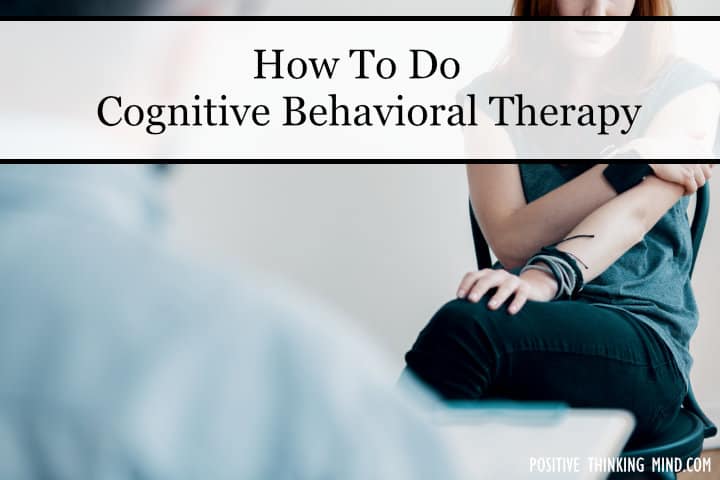How To Do Cognitive Behavioral Therapy
Cognitive Behavioral Therapy or CBT is the number one recommended evidence-based treatment for mental health ailments such as anxiety and depression.
So how do you do cognitive-behavioral therapy? We are going to dive in and learn what cbt is, how it’s useful, what it’s suitable for, and primarily learn how to do cognitive-behavioral therapy.
Cognitive Behavioral Therapy is meant to change our conscious and unconscious negative thought patterns, behaviors, attitudes, and respond to stressful situations more effectively.

How To Do Cognitive Behavioral Therapy
Cognitive Distortions
- Catastrophizing – expects the worst things will happen
- Fairness fallacy – assumes everything is life should be fair
- Control fallacy – thinks others are to blame or self is to blame
- Personalization – believes self is always to blame
- Blaming – always someone else’s fault
- Overgeneralizing
- Jumps to conclusions
- Polarized thinking
- Filtering – Only focusing on the negative and not the whole picture
- Always expects others to change
- Labeling – extreme generalization
- Emotional Reasoning
- Heaven’s reward fallacy – believes that all their sacrifice, self-denial, and righteous actions are watched by a higher power and will be rewarded.
- Should or Should not’s
What Is CBT Used For?
CBT is a form of treatment and is effective at helping anxiety disorders, depression, alcohol, and drug use, eating disorders, marital problems, and severe mental illness.
You and your therapist can use this therapy, which is one of the most widely used tools for anxiety and has shown substantial improvements by as much as 60% effective according to research.
Significant improvement can be obtained within 12-20 treatment sessions.
The main focus of cognitive-behavioral therapy is Automatic Negative Thoughts or what I like to call “ANTS.” These negative thoughts help contribute to depression and anxiety and are usually accepted as being valid.
When you examine your thoughts and are encouraged to look at the situation with facts and evidence from a reality-based standpoint, this will help you disprove the negative feelings you are having.
Related: Handling Your Negative Thoughts The Positive Way
How To Prepare For Cognitive Behavioral Therapy
- Review what you would like to accomplish. Think about what issues you would like to work on. You can figure most of this with your therapist; it is good to have an idea and a starting point.
- Find a therapist. The first talk to your doctor, they can write a referral. Next, start with your insurance company, you can also ask a friend if they have suggestions. Your employer may also offer counseling services or referrals through the employee assistance program (EAP). You could even search on the internet.
- Figure out the cost. If you have health insurance, call them, and find out how much they cover for psychotherapy. Most health plans will cover only a certain number of sessions a year. Talk to your therapist about their fees.
Next, research the therapists’ qualifications by looking into their background and education, their certification and licensing, and last what area of expertise they are trained in.
Most therapists have a master’s or doctoral degree with specific training in psychological therapy.
What To Expect In CBT Therapy
During your first session, your therapist will usually gather information from you to create a plan and get to know you better.
The therapist will ask about your current mental status as well as your past. They may also ask about your childhood to understand what type of environment you grew up in as well as family history.
During your first therapy session, it is good also to get to know your therapist and find out if they are a good fit for you.
Ask them questions and find out:
- The length of sessions
- How many therapy sessions you may need
- Type of therapy appropriate for you
- How they will approach or help your condition
During Your CBT Sessions
You will talk about your thoughts and feelings and things that are troubling you. You may be asked to do some homework, whether it be reading or activities to help with your therapy.
During your sessions, you will be working on the following steps:
- Identify your situation and what your concerns are
- You will be aware of your thought and emotions and how you perceive things
- Identify your negative or untrue thinking
- Begin to work on changing your negative thoughts and transform them into more positive thinking
Length Of Your CBT Therapy
The duration of your therapy is usually dependant on the severity of your disorder or situation.
Typically cognitive behavioral therapy will last for five to twenty sessions.
You and your therapist can discuss your therapy and factors that will come into consideration could be:
- the severity of your symptoms
- how fast you progress
- stress levels
- type of disorder
- friends and family support you receive
- length of time dealing with your situation
Remember, it took many years for you to learn these negative behaviors and thoughts. It will take time and practice to learn to think healthier and with purpose. Here are a few exercises that may help you with your therapy.
I wish you luck on your journey and have learned a bit about how to do cognitive behavioral therapy.
